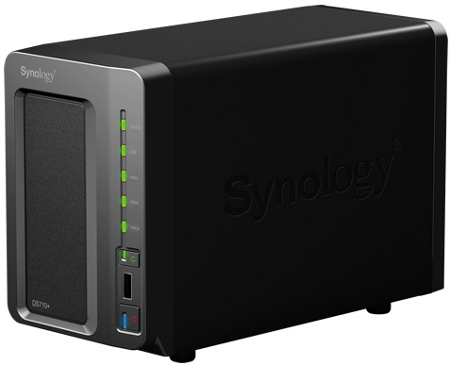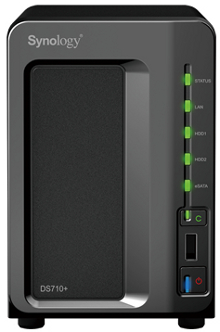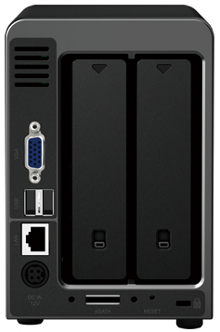Two-bay NAS device can expand to seven bays
Feb 15, 2010 — by Eric Brown — from the LinuxDevices Archive — 1 viewsSynology America announced a two-bay member of its DiskStation network-attached storage (NAS) family that can expand via an optional seven-bay expansion enclosure from 4TB to up to 14TB. Aimed at small-to-medium businesses, the DiskStation DS710+ runs Linux on an Intel Atom D410, and supplies gigabit Ethernet and USB connectivity.
In December, Synology shipped another, less expandable two-bay NAS device, the DS210j model, which offered an unnamed 800MHz processor, a gigabit Ethernet port, and two USB ports. The DS710+'s design, however, is closer to that of Synology's five-bay, Intel Atom D510-based DS1010+ announced last month, which, like this new entry, is compatible with the company's DX510 seven-bay expansion enclosure.

Synology DS710+
Synology accompanies the D410 CPU with 1GB DDRII RAM, as well as a gigabit Ethernet port, three USB ports, and an eSATA port. In its standard two-bay configuration, the DiskStation DS710+ supports up to 4TB using either 3.5-inch SATA hard disk drives (HDDs) or 2.5-inch SATA HDDs or solid-state drives (SSDs). By adding the optional DX510 expansion enclosure, however, users can expand the device up to 14TB, the better to meet the needs of growing small businesses without requiring a system change, says the company.


DS710+ (front and back)
DSM app to add RAID and cloud features
Like the DS210j, the DS1010+, and other Synology NAS devices, the DS710+ runs version 2.2 of Synology's Linux-based, DNLA-compliant Disk Station Manager software, which is compatible with Linux, Windows, and Mac workstations. DSM 2.2 enables automated backup features, remote file sharing, iSCSI target support, and multimedia streaming, says the company.
The software also includes a DNLA-compliant media server, the Photo Station 3 photo management application, and a built-in PHP + MySQL server, which enables remote web-based sharing of photos and other content. In addition, DSM 2.2 includes Surveillance Station 3, which lets users set up a surveillance station for up to 20 connected IP cameras. The software is said to support Apple's Time Machine, as well as two iPhone Applications: DS audio and DS photo.
Synology recently released a beta version of DSM 2.3, which is scheduled for final release in March. DSM 2.3 adds a volume manager app, as well as a Synology Hybrid RAID (SHR) feature, which is said to optimize the use of disk capacity with data protection when using HDDs of different sizes. Other new features will include "share level encryption" and backup to the cloud with the Amazon S3 service, says Synology.
Stated Doug Self, product specialist at Synology America, "Companies are looking for affordable solutions to manage their data that will be flexible as their business grows and that is affordable right now to integrate into existing IT structures."
Availability
The DiskStation DS710+ Diskless will ship in the U.S. and Canada at the end of February, and the DiskStation DS710+ 2100, which presumably offers pre-installed HDDs, will be shipping in the U.S. at the same time. The DX510 expansion enclosure is set to ship in March, says Synology America. More information may be found here.
This article was originally published on LinuxDevices.com and has been donated to the open source community by QuinStreet Inc. Please visit LinuxToday.com for up-to-date news and articles about Linux and open source.